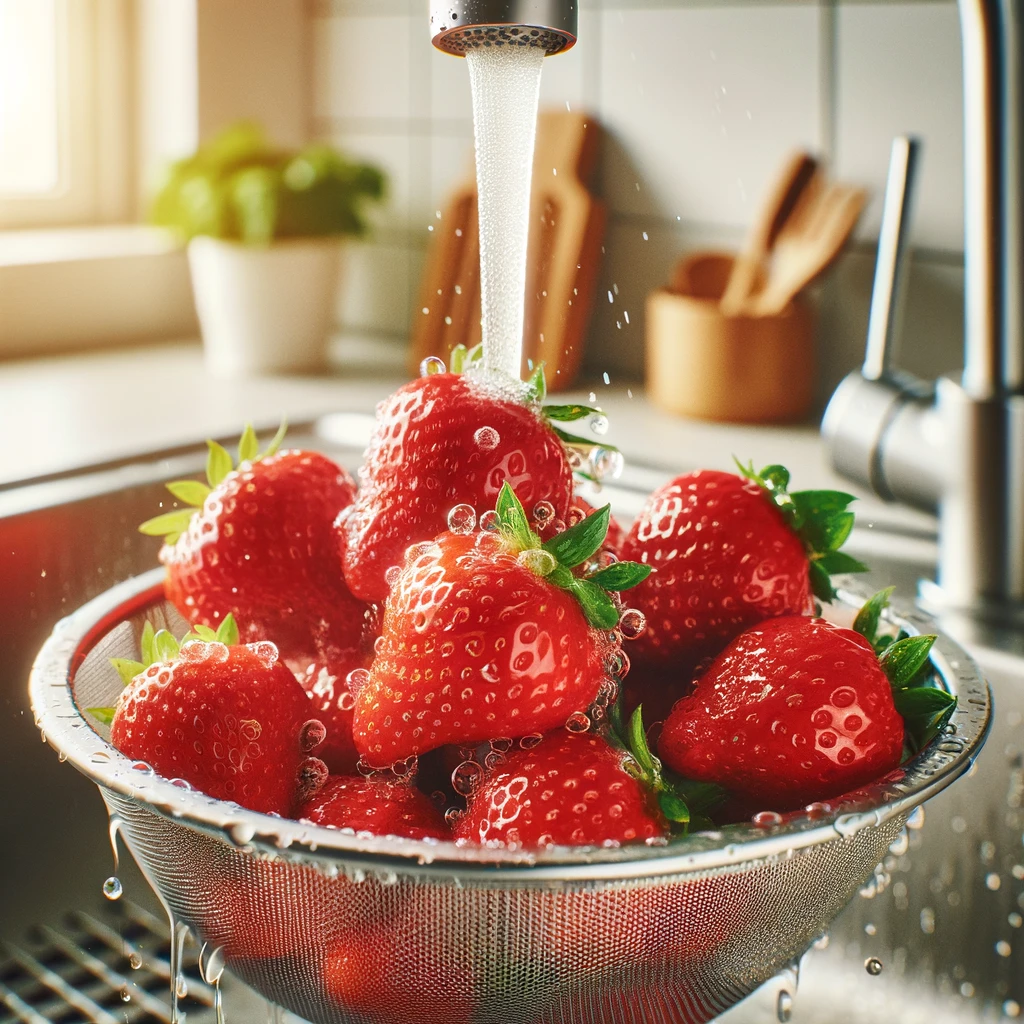
Are you tired of biting into a juicy strawberry only to discover it’s gritty or has a lingering taste of chemicals?
Learning how to clean strawberries properly is essential for enjoying this delicious fruit at its best.
In this guide, we will walk you through the step-by-step process of cleaning strawberries to ensure they are safe, fresh, and tasty to eat.
Understanding Why Proper Strawberry Cleaning is Essential
Strawberries, while delicious and versatile, are particularly vulnerable to a variety of contaminants due to their growth habits.
Typically, these succulent fruits are cultivated close to the ground, which naturally predisposes them to accumulate not just soil and dirt but also potentially harmful bacteria.
Pesticides
Moreover, in an effort to ward off pests and diseases, strawberries are often treated with pesticides.
These chemicals, while necessary for ensuring a fruitful harvest, can linger on the surface of the strawberries even after they have been harvested.
This combination of factors underscores the importance of meticulous strawberry cleaning.
Neglecting to properly wash strawberries can result in the consumption of unwanted residues and microorganisms.
Pesticides, for instance, are designed to be toxic to certain pests, and their residue on fruit can be of concern to humans as well.
While the level of pesticides on commercially available strawberries is regulated, minimizing exposure by thorough cleaning is advisable for those seeking to reduce their intake of these chemicals.
Bacteria
Similarly, bacteria such as E. coli and Salmonella, which can be present in soil, pose a serious health risk if ingested.
Strawberries’ bumpy and porous surface provides numerous nooks and crannies where these bacteria can hide, making them harder to clean than fruits with smoother surfaces.
A diligent washing process is therefore crucial to mitigate the risk of foodborne illnesses that can result from consuming contaminated produce.
Consumed Raw
Furthermore, the fact that strawberries are frequently consumed raw increases the importance of thorough cleaning.
Cooking can often serve as a means to eliminate bacteria and reduce pesticide residues, but since strawberries are typically eaten fresh, the responsibility to ensure their cleanliness falls entirely on the preparation process.
Proper washing techniques thus become indispensable for enjoying these berries in their most common and appreciated form.
In essence, understanding the reasons behind the necessity of proper strawberry cleaning is fundamental.
By recognizing the potential risks associated with contaminated strawberries, individuals can adopt effective cleaning strategies to enjoy this beloved fruit safely and to its fullest taste potential.
Gather Your Strawberry Cleaning Supplies
To ensure a thorough and effective cleaning of your strawberries, it’s important to have the right tools at your disposal.
Colander
The supplies you’ll need are simple, yet critical for the process. First, secure a colander.
This kitchen tool is indispensable for rinsing strawberries, allowing water to flow through while catching the berries and preventing them from soaking in standing water, which can cause them to become soggy.
Large Bowl
Next, you’ll need a large bowl.
This bowl will be used to create a vinegar-water solution that serves to deeply cleanse the strawberries, helping to remove any pesticides or bacteria more effectively than water alone.
It’s advisable to choose a bowl that is large enough to accommodate all your strawberries without crowding them, ensuring each berry is exposed to the cleaning solution evenly.
Cold Water
Cold water is essential for both rinsing and preparing the vinegar solution.
Cold water is preferred as it does not cause the strawberries to become mushy, which can happen with warm or hot water.
Additionally, cold water helps preserve the firmness and freshness of the berries during the cleaning process.
White Vinegar
White vinegar is a key ingredient in your strawberry cleaning arsenal.
Its natural acidity helps to break down and remove contaminants from the strawberries’ surfaces without leaving harmful residues.
When diluted with water, it creates an effective cleaning solution that is safe for consumption.
Paper Towels
Finally, have paper towels ready for drying the strawberries after they’ve been rinsed.
Paper towels are preferable to cloth towels because they are disposable and less likely to harbor bacteria.
They also do a great job of gently blotting away moisture without crushing the delicate fruit.
By assembling these supplies before you begin cleaning, you’ll streamline the process and ensure that your strawberries are cleaned efficiently and effectively, ready to be enjoyed in their freshest and most delicious state.
Quick Inspection and Preliminary Sorting

Before you begin the washing process, it’s imperative to conduct a preliminary inspection and sorting of your strawberries.
This step is crucial for identifying any strawberries that may compromise the quality of your batch due to mold, spoilage, or physical damage.
Spread Them Out
Start by spreading out your strawberries on a clean surface, making it easier to examine each berry individually.
As you inspect, look for signs of mold—usually white or green fuzzy spots—that indicate the strawberry is past its prime and should not be consumed.
Similarly, strawberries with significant bruises or soft spots are more susceptible to mold and bacterial growth and should be removed from your batch.
This is not only for the sake of food safety but also to prevent the spread of mold to healthy berries when stored together.
Remove The Overly Ripe Ones
Next, check for any strawberries that are overly ripe or show signs of decay.
While these may not pose an immediate health risk, their compromised texture and flavor can detract from the overall enjoyment of your strawberries.
It’s best to set these aside for immediate use in smoothies or baking, where their altered state is less noticeable.
Remove Stems and Leaves
Additionally, this is the perfect time to remove the stems and leaves from each strawberry.
The green tops can harbor dirt and bacteria, which could contaminate your cleaning solution or even the other strawberries if not removed.
Using a small knife or a specialized strawberry huller, carefully remove the leaves and the stem, ensuring not to cut too deeply into the berry itself to avoid unnecessary waste.
Sorting your strawberries in this manner not only ensures that you’re starting the cleaning process with the best quality fruit but also helps in reducing potential health risks associated with consuming spoiled or contaminated strawberries.
This step, though simple, is an essential part of preparing your strawberries for a thorough cleaning, setting the stage for a delicious and safe eating experience.
Rinsing Your Strawberries Under Cold Water
Once you’ve conducted a thorough preliminary sorting of your strawberries, removing any that are spoiled or damaged, it’s time to move on to the crucial step of rinsing.
Use a Colander
For this step, you will need a colander. Begin by gently placing your sorted strawberries into the colander.
This method ensures that each berry can be individually addressed without being subjected to the harsh pressure of a running tap, which might cause bruising or damage to their delicate skin.
Under a Gentle Stream
Proceed by turning on the cold water tap and adjusting the flow to a gentle stream.
Cold water is imperative as it helps maintain the structural integrity of the strawberries, keeping them firm and fresh.
Rotate and Agitate
Carefully rotate and agitate the strawberries within the colander, ensuring that the water reaches and cleanses every part of the berries.
This action helps to dislodge any remaining dirt, dust, or other fine particles that might be clinging to their surfaces.
Brush Lightly
As you rinse, use your fingers to lightly brush the surfaces of the strawberries.
This manual action is gentle yet effective in removing any stubborn residues or particulate matter that might be adhering to the berries.
It’s important to perform this step with care, as applying too much pressure can easily damage the strawberries, making them unsuitable for storage or immediate consumption.
It is also worth noting that while rinsing under cold water is highly effective for removing visible dirt and reducing surface residues, this step by itself might not eliminate all pesticides or bacteria.
However, it serves as an essential part of the overall cleaning process, preparing the strawberries for a subsequent vinegar bath, should you choose to use that method for a deeper clean.
Once the strawberries have been thoroughly rinsed, they are ready for the next phase of cleaning or for drying, if you’re opting to skip the vinegar solution step.
Remember, the goal of this rinsing process is to ensure that each strawberry is as clean as possible while preserving its freshness and natural flavor.
Using Vinegar Solution for a Deep Clean

To embark on a more comprehensive cleaning process, it’s recommended to utilize a vinegar solution, which effectively enhances the removal of both pesticides and bacteria from your strawberries.
Submerge Strawberries
Begin this method by combining one part white vinegar with three parts cold water in a sizable bowl, ensuring the mixture is ample to fully submerge the batch of strawberries you’re preparing to clean.
The acidity of the vinegar serves as a natural disinfectant, breaking down contaminants more efficiently than water alone.
Once your solution is prepared, gently place the strawberries into the bowl, making sure each berry is fully immersed in the mixture.
Soaking Period
Allow the strawberries to soak in this vinegar bath for approximately five minutes.
This duration is crucial as it provides sufficient time for the vinegar to penetrate and cleanse, yet is brief enough to prevent the vinegar from seeping into the fruits and altering their natural taste.
After the soaking period, it’s imperative to eliminate any lingering vinegar taste and ensure the strawberries are palatable.
Rinse Thoroughly
To achieve this, remove the strawberries from the vinegar solution and proceed to rinse them thoroughly under cold running water.
This step is vital for washing away any residual vinegar, thus averting any potential aftertaste.
Throughout this process, handle the strawberries with care to maintain their integrity.
The objective here is to not only cleanse the strawberries but to preserve their fresh, inviting quality.
Employing a vinegar solution in your cleaning regimen is a powerful way to ensure your strawberries are not only visually appealing but are also devoid of unwanted chemical residues and bacterial contaminants, making them safer and more enjoyable to consume.
Drying Your Strawberries Properly
After the thorough cleaning process, whether it be just a rinse or a vinegar solution bath, the next crucial step is to ensure your strawberries are dried efficiently.
This step is not to be underestimated, as proper drying can significantly impact the longevity and quality of your strawberries.
Layer Paper Towels
To start, spread out a layer of paper towels on a clean, flat surface.
Carefully remove the strawberries from the colander or bowl, and place them on the paper towels in a single layer to avoid overcrowding.
Don’t Overcrowd
Overcrowding can trap moisture between the strawberries, potentially leading to quicker spoilage.
Dab
Using additional paper towels, gently dab the tops and sides of the strawberries.
The goal here is to blot away any remaining water without applying too much pressure that could bruise or damage the delicate fruit.
It’s important to be thorough yet gentle during this process to ensure that the strawberries are dry to the touch, which helps in preventing mold growth once they are stored.
Air Dry
An alternative method for those who prefer not to use paper towels is to let the strawberries air dry.
This can be done by placing the strawberries on a clean kitchen towel or a rack, ensuring they are spread out with enough space between each berry for air to circulate freely.
Air drying is a more environmentally friendly option and can be just as effective, although it may take longer for the strawberries to fully dry.
Once the strawberries are completely dry, proceed to the next step of storing them properly.
Keep in mind, skipping or rushing through the drying process can negate the efforts of cleaning the strawberries by leaving moisture that promotes bacterial growth and mold.
Ensuring your strawberries are thoroughly dried is a pivotal step in preserving their freshness, taste, and nutritional value.
Storing Cleaned Strawberries for Freshness

After the strawberries have been meticulously cleaned and dried, the next crucial step is to store them in a manner that maintains their freshness and extends their shelf life.
It’s important to choose a container that allows the strawberries to breathe, preventing moisture buildup which can lead to mold and spoilage.
Line Container
A great option for storage is a container with a loose-fitting lid or one that has ventilation holes. Before placing the strawberries inside, line the container with paper towels.
These paper towels play a crucial role by absorbing any residual moisture, keeping the strawberries dry and less prone to spoiling.
Single Layer
When placing the strawberries in the prepared container, be sure to spread them out in a single layer if possible.
This arrangement minimizes contact between the berries, reducing the risk of bruising and ensuring that air circulates around each strawberry.
Avoid the temptation to pack too many strawberries into one container, as overcrowding can trap moisture and heat, accelerating decay.
Refridgerate
Once the strawberries are arranged in the container, place it in the refrigerator.
The cool temperature of the fridge further inhibits bacterial growth and helps preserve the strawberries’ freshness.
Consume Within a Few Days
However, even in the ideal storage conditions, it’s best to consume the strawberries within a few days. Over time, even the cleanest and best-stored strawberries will begin to lose their firmness and flavor.
Freezing
For those who prefer to plan ahead, remember that cleaned strawberries can also be frozen for longer storage.
Spread the dried strawberries out on a baking sheet to freeze individually, and then transfer them into airtight containers or freezer bags.
This method is perfect for preserving strawberries for use in future recipes, smoothies, or desserts.
Proper storage is the final step in ensuring your strawberries remain as delightful as the day you brought them home.
By following these guidelines, you’re not just storing strawberries; you’re preserving the taste of summer.
Enjoying Your Clean Strawberries

With your strawberries now impeccably cleaned and stored, the delightful task of indulging in their sweetness awaits.
These berries, pristine and bursting with flavor, stand ready to elevate any dish they grace.
Incorporate Into Meals
Incorporating them into your meals and snacks not only adds a splash of color but also a bounty of health benefits, thanks to their high vitamin C content and antioxidants.
Craft a vibrant salad by tossing your strawberries with mixed greens, nuts, and a light vinaigrette for a refreshing side dish.
Or, blend them into smoothies for a nutritious breakfast option that feels like a treat.
For dessert, dip strawberries in dark chocolate and chill them until set, offering a decadent yet healthful indulgence.
Beyond these suggestions, strawberries make a versatile addition to cereal, yogurt, or simply served with a dollop of whipped cream for a quick and satisfying snack.
Their natural sweetness and juicy texture make them a favorite among both adults and children, ensuring they’re a hit in any form.
Embrace the joy of experimenting with these clean, fresh strawberries in your culinary endeavors.
Each bite is a reminder of the care taken in their preparation, from cleaning to storage, ensuring they’re enjoyed in their most delicious state.
Let the natural beauty and flavor of strawberries shine in your dishes.
Related Articles:
Healthy Habits Start with Clean Fruit: How to Clean Fruit Like a Pro
Soft Shell Crab 101: Buy, Clean, Cook, and Eat Like a Pro
As an Amazon Associate, I earn commission from qualifying purchases.




